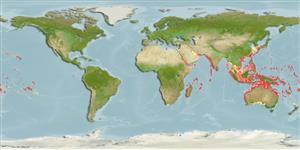Common names from other countries
Environment: milieu / climate zone / depth range / distribution range
Ecologie
marien rifbewoner; standvastig; diepte 0 - 60 m (Ref. 89972). Tropical; 30°N - 20°S
Indo-Pacific: Red Sea and East Africa (extending to Mossel Bay, South Africa, Ref. 5372) to the Hawaiian, Marquesan, and Ducie islands, north to southern Japan, south to Lord Howe and Rapa islands.
Lengte bij maturiteit / Grootte / Gewicht / Leeftijd
Maturity: Lm 13.0 range ? - ? cm
Max length : 25.0 cm TL mannelijk / geslacht onbekend; (Ref. 129178)
Dorsale stekels (totaal) : 12 - 13; Dorsale zachte stralen (totaal) : 22 - 25; Anale stekels: 3; Anale zachte stralen: 19 - 21.
May be seen in a variety of habitats ranging from rich coral reefs (Ref. 58652) to weedy and rubble covered areas (Ref. 1602). Benthopelagic (Ref. 58302). Maybe found singly, in pairs, and in aggregations that roam over large distances in search of food. Feed mainly by tearing pieces from polychaetes, sea anemones, coral polyps, and algae (Ref. 1602). Oviparous (Ref. 205). Form pairs during breeding (Ref. 205). Minimum depth reported taken from Ref. 128797.
Levenscyclus en paargedrag
Maturities | Voortplanting | Spawnings | Egg(s) | Fecundities | Larven
Distinct pairing (Ref. 205). Monogamous mating is observed as both obligate and social (Ref. 52884).
Allen, G.R., 1985. Butterfly and angelfishes of the world. Vol. 2. 3rd edit. in English. Mergus Publishers, Melle, Germany. (Ref. 4858)
Status op de Rode Lijst van het IUCN (Ref. 130435)
CITES (Ref. 128078)
Not Evaluated
Gevaar voor de mens
Reports of ciguatera poisoning (Ref. 130160)
Gebruik door de mens
Visserij: van minder commercieel belang; Aquarium: Commercieel
Tools
Speciale rapporten
Download XML
Internetbronnen
Estimates based on models
Preferred temperature (Ref.
115969): 25.5 - 29, mean 28 (based on 922 cells).
Fylogenetische diversiteitsindex (Ref.
82804): PD
50 = 0.5000 [Uniqueness, from 0.5 = low to 2.0 = high].
Bayesian length-weight: a=0.02512 (0.01625 - 0.03883), b=2.98 (2.85 - 3.11), in cm Total Length, based on LWR estimates for this species & Genus-body shape (Ref.
93245).
Trofisch niveau (Ref.
69278): 3.7 ±0.3 se; based on diet studies.
Weerstandsvermogen (Ref.
120179): Hoog, minimale populatieverdubbelingstijd minder dan 15 maanden (K = 1.5;).
Fishing Vulnerability (Ref.
59153): Low vulnerability (23 of 100).
